Gadgets – TechCrunch
This robot can build your IKEA furniture
There are two kinds of people in the world: those who hate building IKEA furniture and madmen. Now, thanks to IkeaBot, the madmen can be replaced.
IkeaBot is a project built at Control Robotics Intelligence (CRI) group at NTU in Singapore. The team began by teaching robots to insert pins and manipulate IKEA parts, then, slowly, they began to figure out how to pit the robots against the furniture. The results, if you’ve ever fought with someone trying to put together a Billy, are heartening.
From Spectrum:
The assembly process from CRI is not quite that autonomous; “although all the steps were automatically planned and controlled, their sequence was hard-coded through a considerable engineering effort.” The researchers mention that they can “envision such a sequence being automatically determined from the assembly manual, through natural-language interaction with a human supervisor or, ultimately, from an image of the chair,” although we feel like they should have a chat with Ross Knepper, whose IkeaBot seemed to do just fine without any of that stuff.
In other words the robots are semi-autonomous but never get frustrated and can use basic heuristics to figure out next steps. The robots can now essentially assemble chairs in about 20 minutes, a feat that I doubt many of us can emulate. You can watch the finished dance here, in all its robotic glory.
The best part? Even robots get frustrated and fling parts around:
I, for one, welcome our IKEA chair manufacturing robotic overlords.
Don’t just stir; Stircle
Although I do my best to minimize the trash produced by my lifestyle (blog posts notwithstanding), one I can’t really control, at least without carrying a spoon on my person at all times, is the necessity of using a disposable stick to stir my coffee. That could all change with the Stircle, a little platform that spins your drink around to mix it.
Now, of course this is ridiculous. And there are other things to worry about. But honestly, the scale of waste here is pretty amazing. Design house Amron Experimental says that 400 million stir sticks are used every day, and I have no reason to doubt that. My native Seattle probably accounts for a quarter of that.
So you need to get the sugar (or agave nectar) and cream (or almond milk) mixed in your iced americano. Instead of reaching for a stick and stirring vigorously for 10 or 15 seconds, you could instead place your cup in the Stircle (first noticed by New Atlas and a few other design blogs), which would presumably be built into the fixins table at your coffee shop.
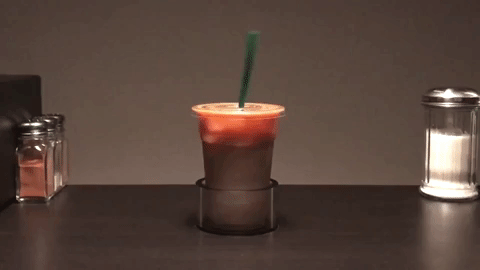
Around and around and around she goes, where she stops, nobody… oh. There.
Once you put your cup on the Stircle, it starts spinning — first one way, then the other, and so on, agitating your drink and achieving the goal of an evenly mixed beverage without using a wood or plastic stirrer. It’s electric, but I can imagine one being powered by a lever or button that compresses a spring. That would make it even greener.
The video shows that it probably gets that sugar and other low-lying mixers up into the upper strata of the drink, so I think we’re set there. And it looks as though it will take a lot of different sizes, including reusable tumblers. It clearly needs a cup with a lid, since otherwise the circling liquid will fly out in every direction, which means you have to be taking your coffee to go. That leaves out pretty much every time I go out for coffee in my neighborhood, where it’s served (to stay) in a mug or tall glass.
But a solution doesn’t have to fix everything to be clever or useful. This would be great at an airport, for instance, where I imagine every order is to go. Maybe they’ll put it in a bar, too, for extra smooth stirring of martinis.
Actually, I know that people in labs use automatic magnetic stirrers to do their coffee. This would be a way to do that without appropriating lab property. Those things are pretty cool too, though.
You might remember Amron from one of their many previous clever designs; I happen to remember the Keybrid and Split Ring Key, both of which I used for a while. I’ll be honest, I don’t expect to see a Stircle in my neighborhood cafe any time soon, but I sure hope they show up in Starbucks stores around the world. We’re going to run out of those stirrer things sooner or later.
Technique to beam HD video with 99 percent less power could sharpen the eyes of smart homes
Everyone seems to be insisting on installing cameras all over their homes these days, which seems incongruous with the ongoing privacy crisis — but that’s a post for another time. Today, we’re talking about enabling those cameras to send high-definition video signals wirelessly without killing their little batteries. A new technique makes beaming video out more than 99 percent more efficient, possibly making batteries unnecessary altogether.
Cameras found in smart homes or wearables need to transmit HD video, but it takes a lot of power to process that video and then transmit the encoded data over Wi-Fi. Small devices leave little room for batteries, and they’ll have to be recharged frequently if they’re constantly streaming. Who’s got time for that?
The idea behind this new system, created by a University of Washington team led by prolific researcher Shyam Gollakota, isn’t fundamentally different from some others that are out there right now. Devices with low data rates, like a digital thermometer or motion sensor, can something called backscatter to send a low-power signal consisting of a couple of bytes.
Backscatter is a way of sending a signal that requires very little power, because what’s actually transmitting the power is not the device that’s transmitting the data. A signal is sent out from one source, say a router or phone, and another antenna essentially reflects that signal, but modifies it. By having it blink on and off you could indicate 1s and 0s, for instance.
UW’s system attaches the camera’s output directly to the output of the antenna, so the brightness of a pixel directly correlates to the length of the signal reflected. A short pulse means a dark pixel, a longer one is lighter, and the longest length indicates white.
Some clever manipulation of the video data by the team reduced the number of pulses necessary to send a full video frame, from sharing some data between pixels to using a “zigzag” scan (left to right, then right to left) pattern. To get color, each pixel needs to have its color channels sent in succession, but this too can be optimized.
Assembly and rendering of the video is accomplished on the receiving end, for example on a phone or monitor, where power is more plentiful.
In the end, a full-color HD signal at 60FPS can be sent with less than a watt of power, and a more modest but still very useful signal — say, 720p at 10FPS — can be sent for under 80 microwatts. That’s a huge reduction in power draw, mainly achieved by eliminating the entire analog to digital converter and on-chip compression. At those levels, you can essentially pull all the power you need straight out of the air.
They put together a demonstration device with off-the-shelf components, though without custom chips it won’t reach those

A frame sent during one of the tests. This transmission was going at about 10FPS.
microwatt power levels; still, the technique works as described. The prototype helped them determine what type of sensor and chip package would be necessary in a dedicated device.
Of course, it would be a bad idea to just blast video frames into the ether without any compression; luckily, the way the data is coded and transmitted can easily be modified to be meaningless to an observer. Essentially you’d just add an interfering signal known to both devices before transmission, and the receiver can subtract it.
Video is the first application the team thought of, but there’s no reason their technique for efficient, quick backscatter transmission couldn’t be used for non-video data.
The tech is already licensed to Jeeva Wireless, a startup founded by UW researchers (including Gollakota) a while back that’s already working on commercializing another low-power wireless device. You can read the details about the new system in their paper, presented last week at the Symposium on Networked Systems Design and Implementation.
SNK may be making a mini-console stuffed with arcade classics
If you’ve worked through the amazing selection of games provided by the NES and SNES Classic Editions, you may be in luck: SNK, the legendary arcade game creator behind the likes of Metal Slug and Samurai Shodown, is teasing what looks like its own tiny arcade cabinet.
Teased as part of the company’s 40th anniversary, the shrouded gadget definitely doesn’t look like a NEO-GEO, or even a NEO-GEO Pocket. Gizmodo notes that the description mentions a “new game machine,” but no details beyond that. The tall, boxy outline suggests a small arcade cabinet, and the slab in front of it looks a lot like an arcade controller.
It wouldn’t be a particularly original creation — there are dozens of tiny arcade cabinets with built-in games, but the truth is, none of them is particularly good. They’re novelties, perfectly fun for a laugh, but the hardware — compared with the impressive solidity of real arcade controllers and the NEO-GEO’s itself — just isn’t there.
If I had to guess, I’d say this is an arcade cabinet-style console with improved internals, a decent screen to accommodate games newer than 1996 and a separate, perhaps even wireless arcade controller. Price… I’d put it at $200 or $250. Extra controller (and you’ll want it), my guess is $60. I could easily be way off, though. Maybe they’d even let us plug in our old Tanksticks?
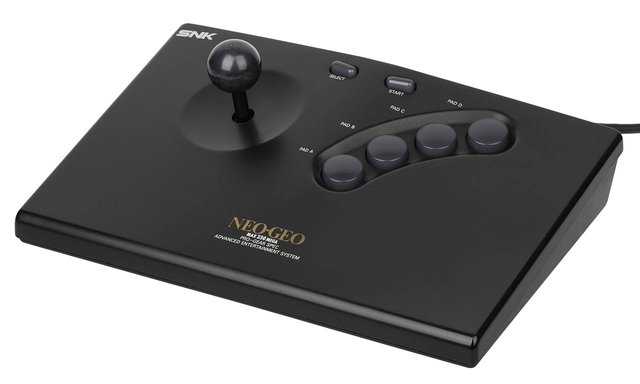
An original NEO-GEO controller. You can feel the sturdiness from where you sit.
Inside, you’ll probably find a generous helping of SNK classics, likely limited to arcade and NEO-GEO titles. Even without SNK’s classic games for home consoles like the NES, my eyes were watering as I scrolled down the list of games the company has put out and which may end up on this device.
King of the Monsters 2? Last Resort? Twinkle Star Sprites? King of Fighters, Samurai Shodown and all the other fighters? Not to mention Metal Slug and its sequels. The amount of quarters I’ve sunk into these fantastic, beautiful games is uncountable.
If SNK is smart, they’ll make it possible to add new games to the system, too. There are plenty to choose from, as the company catered to a number of niches. Having them available for a few bucks each would be a dream — and anyway, if this isn’t a possibility, people will just hack new ROMs onto the system.
Whatever the case is, you can be sure I’m already jockeying for position to review the thing. I’ll let you know the second I hear anything.
Jaquet Droz is shipping its mechanical signing machine
Watchmaker Jaquet Droz announced its Signing Machine — a mechanical device that will sign your name for you using a series of miniature gears and springs — in 2014. Four years later, the company is ready to ship their miraculous contraption just in time for you to ink the deal you’ve made with Cybereus, lord of the digital underworld.
This exquisitely baroque gadget is essentially a little cartridge full of clockwork. You wind it up, stick a pencil in its tiny retractable claw, and let it go. The gears and levers recreate your signature with a series of flowing strokes generated by the movement of the gears.
Droz, an 18th century watchmaker and automaton manufacturer, was famous for his miraculous contraptions, including a Draughtsman and Writer, two human-shaped robots that could draw and write, along with his beautiful singing birds that used tiny pipes and bellows to recreate birdsong.
The Signing Machine is activated after you enter your four-digit code into the the device, and each unit is individually decorated for the owner.
How much does this bit of titanium jimcrackery cost? It starts at $367,500 and goes up depending on your signature. Too much? Just remember: Making deals with the cryptodemons of the digital underworld isn’t cheap. You’ll need something like this oddly tactical piece of metal to truly widen their hooded, red-shining eyes.
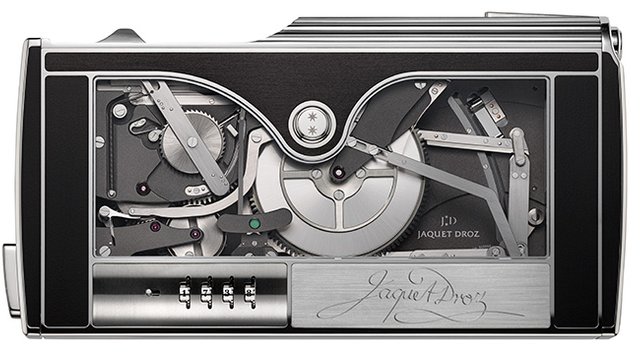
Amazon’s new ‘Alexa Blueprints’ let anyone create custom Alexa skills and responses
Amazon this morning is introducing “Alexa Blueprints,” a new way for any Alexa owner to create their own customized Alexa skills or responses, without needing to know how to code. The idea is to allow Alexa owners to create their own voice apps, like a trivia game or bedtime stories, or teach Alexa to respond to questions with answers they design – like “Who’s the best mom in the world?,” for example.
You could also create a skill that includes helpful information for the babysitter, which could be triggered by the command, “Alexa, open My Sitter,” Amazon suggests.
“Alexa Skill Blueprints is an entirely new way for you to teach Alexa personalized skills just for you and your family,” explained Steve Rabuchin, Vice President, Amazon Alexa, in a statement about the launch. “You don’t need experience building skills or coding to get started—my family created our own jokes skill in a matter of minutes, and it’s been a blast to interact with Alexa in a totally new and personal way.”
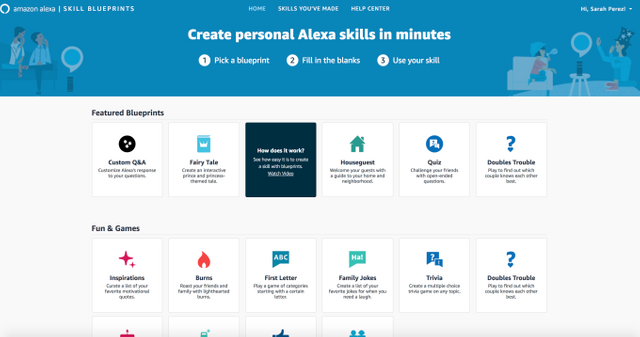
To build your own skill or custom Alexa response, users will visit the website blueprints.amazon.com and select a template.
At launch, there are over 20 templates across categories like Fun & Games, At Home, Storyteller, and Learning & Knowledge.
The templates are designed so you can just fill in the bits and pieces that make them personalized to your needs. You won’t need to go through a series of complicated steps, and no technical knowledge is required. The templates are even pre-filled and work as is, if you just want to try them out before making your own.
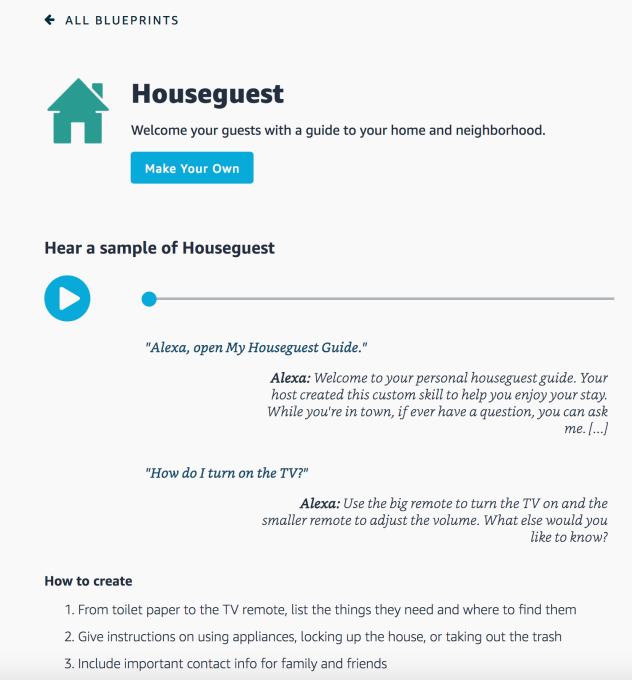
After you’ve filled in your own content, you name it and publish with a click. This makes the skill or response available to all Alexa-enabled devices associated with your own Amazon account. But it’s not available to the public or the Alexa Skills Store.
Families with Echo devices, in particular, seem to be a heavy focus for Alexa Blueprints. Kids have readily taken to Alexa, and today there are nearly 500 public Alexa skills built for kids alone. Families also often have private jokes and bedtime rituals where Alexa could come in – offering to “tell a Dad joke” or “start Anna’s story,” for instance. Plus, Alexa is designed as a home companion – controlling smart devices, playing music, setting timers, and offering information like news and weather, among other things.
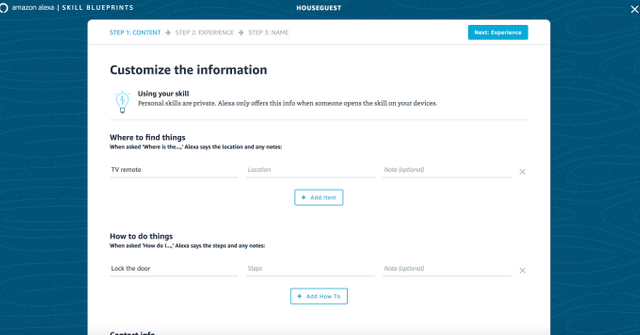
But families aren’t the only ones would could take advantage of Alexa Blueprints. College students could use the flash cards custom skill when studying, while a group of friends or roommates could design their own trivia games. And Airbnb owners could set up a skill for their houseguests.
After you’ve created the custom skill, it will be available in the Skills You’ve Made webpage on the Blueprints site. You’ll also be able to enable, disable and delete your skills.
The feature could give Amazon an edge in selling its Echo speakers to consumers, as it’s now the only platform offering this level of customization – Apple’s HomePod is really designed for music lovers, and doesn’t support third-party apps. Google Home also doesn’t offer this type of customization.
All three are competing to be the voice assistant people use in their home, but Alexa so far is leading by a wide margin – it still has roughly 70 percent of the smart speaker market.
Alexa Blueprints are available today in the U.S. only.
The full list of Alexa Blueprints available at launch is below:
At Home
- Custom Q&A: Customize responses to your questions
- Houseguest: Make your guests feel at home with quick access to important info
- Babysitter: Help your sitter find things, remember steps and get important info
- Pet Sitter: Help your pet sitter care for your favorite animal
Fun & Games
- Family Jokes: Create a list of your favorite jokes for when you need a laugh
- Trivia: Create your own multiple choice trivia game on any topic
- Inspirations: Curate a list of your favorite inspirational quotes
- Family Trivia: Play together and brush up on family history
- Bachelorette Party: Play to find out how well the bride’s friends know her
- Birthday Trivia: Play to see who knows the birthday girl or boy best
- Burns: Roast your friends and family with lighthearted burns
- Compliments: Flatter your favorites with a list of custom compliments
- Double Trouble: Find out which couple knows each other best with this customizable game
- First Letter: Play a game of categories starting with a certain letter
Storyteller
- Adventure: Write an adventure story where your child is the hero
- Fairy Tale: Customize an interactive prince and princess-themed tale
- Sci-Fi: Create an interactive story with a far-out theme
- Fable: Create a short narrative with a moral of the story
Learning & Knowledge
- Flash Cards: Study, test yourself, and master any subject by voice
- Facts: Keep a list of facts on your favorite topic, all in one place
- Quiz: Challenge yourself and others with a customizable quiz
Source: https://techcrunch.com/
This user is on the @buildawhale blacklist for one or more of the following reasons:
You got a 16.67% upvote from @luckyvotes courtesy of @tokenguy!
You got a 2.93% upvote from @brandonfrye courtesy of @tokenguy!
Want to promote your posts too? Send a minimum of .10 SBD or Steem to @brandonfrye with link in the memo for an upvote on your post. You can also delegate to our service for daily passive earnings which helps to support the @minnowfund initiative. Learn more here